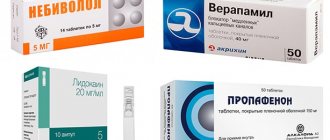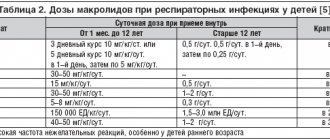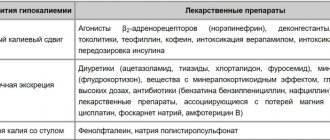The problem should not be ignored, because the substance in question is considered a very important electrolyte present in muscle cells, working together with sodium. It is potassium that ensures proper muscle contraction, and its lack can lead to frequent cramps, decreased strength potential, and tissue dehydration. Potassium preparations are presented in quite a large number to choose from, so special attention should be paid to determining the most suitable remedy. Here you need to take into account the composition, quantity and mass fraction of components in order to achieve maximum effect. Potassium can be presented in the form of an independent preparation, or also be part of various preparations necessary for rehydration.
Why do we need potassium supplements?
One of the most important metabolisms in the human body is electrolyte metabolism. Potassium plays a leading role in it, since it regulates the water content in cells and participates in maintaining the intracellular chemical composition necessary for normal life. The main property of potassium is the ability to form cellular electrical potential, conduct nerve impulses, contracting smooth muscle, which is part of the structure of almost all vital internal organs and vascular walls.
Due to this, potassium-containing preparations can:
- regulate blood pressure through the sympathetic system;
- increase cell sensitivity to insulin by activating the enzymatic activity of carbohydrate-protein metabolism;
- stimulate the contractility of the heart;
- stop sinus arrhythmias;
- maintain normal functioning of the genitourinary system.
In the body, potassium is in a bound state (up to 98%), localized in cells. Only a couple percent circulates in the blood, actively interacting with other electrolytes. Magnesium is its companion, the element prolongs the effect of potassium in the muscles. Sodium is an antagonist, removing both potassium and magnesium from the bloodstream. The balance between sodium and potassium-magnesium is the basis for the normal functioning of the heart and other internal organs.
With increased stress on the heart, previous infections, weakened immune forces, stress, 2% potassium in the bloodstream is insufficient. Then it is replaced by sodium. This is very simple, since a person gets sodium every day from table salt. But the biochemical processes change radically.
Sodium retains water in the body, the total volume of circulating blood increases, an excess of water occurs in the cells, they swell, and the tissues become pasty. An additional load is placed on the heart, which the myocardium cannot always cope with. Magnesium is also washed out with potassium, vasospasm occurs, blood pressure rises, signs of hypoxia appear, and cramps occur in the legs.
In order not to disturb the potassium-sodium balance, potassium is additionally introduced into the body in the form of tablets or by injection.
IMPORTANCE OF POTASSIUM FOR CVS
Let's take a closer look at the effect of potassium on heart function. The electrical activity of myocardial cells depends on transmembrane ionic gradients, as well as on time- and voltage-dependent disturbances in the conduction of ionic currents. Electrolyte abnormalities can cause or facilitate the development of clinically significant arrhythmias even in normal cardiac tissue by modulating ion conduction through specific myocardial ion channels. The Na+ current into the cell upon activation of Na+ channels forms a phase of rapid depolarization in cardiomyocytes. As depolarization increases, permeability to Na+ decreases due to inactivation of Na+ channels, but channels for incoming Ca++ currents, which are necessary for the formation of the plateau phase, open. Subsequent activation of potassium channels leads to repolarization of the cardiomyocyte membrane to the level of the PP. Potassium, especially extracellular potassium, is the most important factor determining membrane PP. The electrophysiological effects of potassium depend not only on its extracellular concentration, but also on the direction (hypo- or hyperkalemia) and the rate of its change. Potassium ion channels are of primary importance for the regulation of the transmembrane potassium gradient. Potassium channels are transmembrane proteins that selectively allow potassium ions to pass through: potassium moves under the influence of an electrochemical gradient at a rate of 106 to 108 ions per second [1]. There are voltage-gated potassium channels and numerous channels that open for potassium ions or are blocked by various substances - ligands of the corresponding receptors. Such channels maintain the background conductivity of membranes for potassium ions and form the PP of excitable and non-excitable cells*. Hypokalemia (<3 mmol/L) reduces membrane permeability to potassium [24]. Thus, the conductance for the incoming (anomalous) potassium rectifying current is proportional to the square root of the extracellular potassium concentration [20, 21]. The dependence of the activation of the delayed (outgoing) rectifying current on the extracellular potassium concentration helps to understand why the AP duration is shorter at high potassium concentrations and longer at low potassium concentrations [31]. But the effects of potassium on the membrane PP are also modulated by the simultaneously created Ca++ concentrations. Their interaction is such that increased Ca++ levels reduce the depolarizing effect caused by increased potassium levels. In turn, low Ca++ levels attenuate the depolarization caused by hypokalemia.
Factors stimulating the transmembrane movement of potassium:
- from the cell to the extracellular space:
– acidosis; – stimulation of α-adrenergic receptors; – digitalis preparations;
- from the extracellular space into the cell:
– alkalosis; – stimulation of β2-adrenergic receptors; – insulin.
Damage to membrane phospholipids in the processes of lipid peroxidation (LPO) also leads to disruption of the barrier function of the membrane and increased potassium loss by the cell. Activation of LPO occurs in pathological conditions such as dystrophy, inflammation, myocardial ischemia, etc.
Indications for the use of drugs with potassium
Obviously, the main indication for the use of potassium-containing products is hypokalemia (blood test for electrolytes), which occurs when:
- post-infarction state;
- CHF;
- fluctuations in blood pressure;
- cardiac ischemia of various origins: angina pectoris, arrhythmias;
- metabolic disorders.
In addition, electrolyte imbalance occurs during treatment with certain medications:
- cardiac glycosides (Digoxin);
- bronchodilators (Berodual);
- steroids (Prednisolone);
- diuretics (Furosemide);
The essence of administering potassium supplements is to replenish externally removed electrolyte reserves.
It should be remembered that not only a deficiency, but also an excess of potassium in the body is dangerous, as it leads to cardiac arrest. Therefore, more than 10 g of a microelement is not prescribed at a time.
Hypokalemia: treatment
The main goal of therapy is to stop the body losing potassium. To do this, it is necessary to eliminate the cause of hypokalemia. At the same time, the deficiency is corrected.
Treatment of hypokalemia with potassium supplements is mandatory. For mild pathological processes, medications are usually prescribed in tablet form, for example, Asparkam or Panangin. In severe cases, intravenous solutions containing potassium chloride or potassium bicarbonate are required. However, intravenous infusions are contraindicated in patients whose problem is caused by impaired potassium redistribution (with the exception of familial hypokalemic periodic paralysis), since the risk of developing rebound hyperkalemia is high.
In some cases, the use of antiarrhythmic drugs - propafenone or amiodarone - is required to eliminate arrhythmia. In case of ventricular fibrillation, defibrillation is necessary.
When potassium supplements are ineffective and why (contraindications)
Despite the effectiveness of correcting pathological conditions associated with potassium deficiency by administering drugs containing the element, there are cases where there are no positive results from such therapy. The problem is a primary deficiency of potassium in the bloodstream due to illness or improper behavior of the person.
Therefore, before prescribing drugs with potassium, it is necessary to accurately establish the cause of its deficiency in the bloodstream. Electrolyte can be removed outside the bloodstream in the following cases:
- nutritional errors: eating insufficient quantities of foods containing potassium (80% of cases): mushrooms, peaches, dried apricots, nuts, dairy products, potatoes, bananas, seaweed, spinach, parsley, soy, cilantro, buckwheat, legumes - on the background excessive salt intake (more than 5 g/day);
- problems with the digestive system - malabsorption, subject to treatment (10% of cases);
- hormonal imbalance in the body: pregnancy (especially multiple births), menopause, puberty, menstruation, taking contraceptives (7%);
- long-term use of diuretics: the only way to correct the condition is to stop taking medications (3%).
Potassium supplements can be recommended only after solving the problem with the root cause of the deficiency of the element.
The simultaneous administration of drugs with potassium-sparing diuretics (Spironolactone, Triamterene, Eplerenone, Amiloride, Triamtezide) poses a fatal threat.
Directions for use and doses
Should be taken orally 1 hour before meals or 4 hours after meals. Adults: 250-500 mg 2-3 times a day. The course of treatment lasts on average 20-30 days. If necessary, treatment can be repeated after 1 month. In exceptional cases, the dose for adults can be increased to 3 g per day. Children - 10-20 mg/kg body weight per day, divided into 3-4 doses (for example, if the child’s body weight is 25 kg, then the allowed dose is from 25 x 10 = 250 mg (1/2 tablet) to 25 x 20 = 500 mg (1 tablet per day, divided into 3-4 doses). Course of treatment is 3-5 weeks. If symptoms of the disease persist, consult your doctor
List of drugs in tablets
There are not many drugs that contain potassium on pharmacy shelves. Medicines in this group are prescribed only by a doctor due to the risk of fatal complications in the event of an overdose. Despite the ease of purchasing and using potassium tablets, self-medication at home is prohibited.
Potassium orotate
The most popular representative of the group is considered to be potassium orotate.
The potassium preparation has been time-tested, well studied, and all its negative and positive sides are known. Potassium orotate is effective for heart diseases, has a powerful electrolyte-balancing effect, demonstrates anabolic properties - it accelerates metabolism. Due to this feature of the drug, potassium orotate is the drug of choice for congestion in the circulatory system
: CHF, cardiosclerosis, myocarditis, heart rhythm disturbances. The medicine helps the rapid regeneration of damaged tissues, therefore it is indicated for acute conditions, myocardial injuries, sclerotic changes in the muscle.
Among the disadvantages of this potassium drug may be noted: dyspepsia, stimulation of kidney function (dangerous in chronic renal failure), impaired absorption of iron and antibiotics, which makes it unacceptable for anemia or infections. Price – 122 rubles.
Potassium-Normin
The combination of electrolyte with chlorine is used in extreme cases, after a full clinical and laboratory examination due to the large number of side effects:
- from the gastrointestinal tract - intestinal obstruction, perforation of the wall, bleeding, ulcerative-erosive processes in the digestive system, epigastric pain, bloating, nausea, dyspepsia;
- from the nervous system - foggy consciousness, myalgia, muscle weakness, paresthesia;
- from the heart and blood vessels - rhythm disturbance, hypotension, cardiac arrest;
- from other systems - allergies up to anaphylaxis, hyperkalemia.
You can purchase the drug Potassium-Normin in pharmacies for a price of 68.6 rubles.
Kalinor
A relatively safe potassium preparation in the form of effervescent tablets based on potassium citrate monohydrate and potassium acid carbonate. It restores the deficiency of the microelement and is used mainly to relieve arrhythmias.
The medicine is contraindicated for:
- dehydration of any origin (hypokalemia);
- decreased kidney function;
- Addison's syndrome;
- Hamstorp's disease.
Side effects are extremely rare and include dyspepsia or allergic rashes. The price of Kalinor is 2,580 rubles.
Calyposis
A potassium preparation that resembles Potassium-Normin in its action, being its prolonged version. It acts much more gently, does not give so many side effects, and there is no need to strictly titrate the dosage.
The main disadvantage is irritation of the gastrointestinal mucosa, but absorption from the intestines is the only way for the drug to enter the body. The cost through online pharmacies is 190 rubles.
MAGNESIUM
Ionized magnesium is in 2nd place after potassium in terms of total content in the cell. The magnesium content in blood plasma is 0.8–1.5 mmol/l; in muscle tissue its content is 10 times higher than in plasma. Thanks to this depot of magnesium in the muscles, its level in the blood can remain stable for a long time even with significant losses. The significance of disturbances in magnesium metabolism is still debated due to the difficulties of measuring it and the common association of these disturbances with other electrolyte disorders [14, 27]. Magnesium is involved in the functioning of muscles and the nervous system, in the regulation of heart rate, cholesterol, lipid, phosphorus and calcium metabolism. It serves as an important cofactor for numerous enzymatic reactions involved in nucleotide and carbohydrate metabolism, protein synthesis and other processes also necessary for normal cardiovascular physiology. Magnesium prevents an increase in blood pressure, enhances inhibition processes in the central nervous system, causing sedative, tranquilizing effects and preventing the manifestations of convulsive activity. Being a natural antagonist of Ca++, magnesium reduces blood clotting and vascular tone [2, 4]. The daily requirement of an adult for magnesium is from 300 to 500 mg. Magnesium deficiency occurs frequently, but its electrophysiological consequences for the myocardium elude scientists even with the most careful study. It is known that the use of magnesium preparations (magnesium) in pharmacological doses is useful for the treatment of torsades de pointes. Toxic effects of magnesium are rare (with the exception of patients with impaired renal function). With magnesium deficiency, nervousness, irritability, and sleep disturbances develop against the background of muscle weakness, increased fatigue and paresthesia. With chronic magnesium deficiency, skeletal deformations are possible: scoliosis, funnel chest, flat feet.
Injectable drugs
To speed up the action of potassium-containing drugs, they are administered by injection. The drug of choice can be considered Potassium chloride (solution from 4% to 10%), which is used to normalize electrolyte metabolism in emergency cases: acute poisoning, infections accompanied by diarrhea, uncontrolled polyuria, hormonal imbalances, overdose of cardiac glycosides. The administration is always controlled by a blood test for electrolyte composition in order to understand the effectiveness of therapy and avoid side effects. Cost – 45 rubles.
An analogue can be considered the combined drug Potassium-magnesium aspartate, which is used for the same indications (129 rubles).
Diagnosis of hypokalemia
Arrhythmic pulse and muscle hypotension are the main symptoms that suggest hypokalemia. To confirm the diagnosis, the following examinations are prescribed:
- Lab tests. A study of the acid-base state of the blood, determination of the content of potassium, magnesium, calcium, sodium, urea and creatinine is required. Urine is examined for the presence of chlorine and its density is determined.
- Hormonal spectrum. A number of hormone tests are performed, including cortisol and aldosterone.
- Electrocardiography (ECG). With hypokalemia, the patient exhibits prolongation of the QT interval and the appearance of a U wave, and sometimes ventricular tachycardia or atrial fibrillation.
Additionally, if necessary, ultrasound, CT, MRI, echocardiography, angiography are performed.
Differential diagnosis is carried out with hyperkalemia, myasthenia gravis, muscular dystrophy, Guillain-Barré syndrome.
Preparations containing potassium and magnesium
Since potassium and magnesium are synergists and improve the absorption and assimilation of each other, they are often combined in tablet formulations. The most popular is the drug with potassium and magnesium - Panangin and Panangin forte in tablets and injections. The tablet form contains potassium and magnesium aspartate, which is considered a transporter of trace element ions and helps potassium and magnesium quickly integrate into the metabolic processes of cells.
Panangin
Panangin is prescribed for arrhythmias of various origins: hypokalemia, poisoning with cardiac glycosides. The drug is effective in case of coronary insufficiency of any etiology, to neutralize the effect of diuretics, which are taken by patients for long courses.
Panangin is considered a vitamin for the heart and is recommended for use by all heart patients in order to prevent heart rhythm disturbances in cases of diagnosed dystrophic changes in the myocardium (ECG control).
The downside is the strong irritating effect on the mucous membrane of the stomach and intestines. The drug is recommended to be taken after meals in a dose calculated by the attending physician based on the patient’s weight. Contraindications are:
- kidney failure in different variants;
- hyperkalemia;
- atrioventricular block.
The cost of Panangin is 144 rubles.
Asparkam
The Russian analogue of Panangin is more affordable in price. Contains the same potassium and magnesium, but in a concentration exceeding the content of microelements in the Panangin tablet. Used as part of complex therapy for diseases of the heart and blood vessels:
- to correct metabolism after a heart attack (can reduce the process of tissue necrosis and localize the area of ischemia);
- relieves heart failure;
- reduces hypertension.
As a prophylactic agent, it is prescribed to prevent predicted hypokalemia (even without balancing the diet). The drug is monitored by blood tests for electrolytes due to the risk of cardiac arrest in case of overdose. Asparkam is contraindicated for:
- renal failure;
- individual intolerance to components;
- heart blockades.
Sometimes when taken, dyspepsia, a feeling of nausea, and allergic rashes occur. Analogs of Asparkam - Pamaton, Asparkad are practically not found in pharmacies today due to the many side effects. The price of Asparkam potassium tablets is 41 rubles.
What is common and special about Panangin and Asparkam?
You can understand the equivalence of replacing one drug with another by highlighting their common points and the features of each. Combines medications with potassium and magnesium:
- same composition;
- use as anticonvulsant therapy (deficiency of microelements leads to contraction of smooth muscles in all organs and tissues);
- release form;
- frequency of administration: one tablet (two - depending on the patient’s weight) three times a day;
- dispensed in a pharmacy without a prescription.
Distinctive features are:
| Panangin | Asparkam |
| Prescribed for: NRS associated with hypokalemia, drug intoxication, long-term use of diuretics, ventricular extrasystoles, coronary insufficiency, heart attack, myocardial hypoxia | Recommended for: arrhythmias due to hypomagnesemia, hypokalemia, myocardial dysfunction, after ventricular arrhythmia to restore rhythm, after taking cardiotonics and antiarrhythmics |
Contains:
| The tablet contains:
|
| Proven benefits for the heart with mitral valve prolapse | No such data |
| The tablet is coated with a protective coating, which reduces the effect of hydrochloric acid on the main active ingredients, the efficiency (efficiency) is higher | There is no shell, the active substances are exposed to gastric juice even after eating, which reduces their effectiveness |
| There are many auxiliary components, which increases the allergenicity of the body and individual intolerance to the drug | There are no other components in the composition, which reduces the risk of individual intolerance |
| Price – 144 rubles | Cost – 41 rubles |
Panaspar
{banner_banstat9}
The drug is a source of potassium and magnesium, corrects hypokalemia, metabolism in the myocardium, improves the tolerance of cardiac glycosides, and is an antiarrhythmic. Prescribed as an adjuvant therapy for myocardial ischemia and hypoxia. Contraindicated in renal failure of any form, metabolic acidosis, heart block, pregnancy. Price – 129 rubles.
Magnerot
{banner_banstat10}
A non-steroidal magnesium and potassium-containing drug that exhibits regenerative and diuretic properties. Electrolytes provide a balance of microelements, improve metabolism, eliminate arrhythmia, and improve heart function. Price – 252 rubles.
Orocamage
A drug containing potassium and magnesium in the form of orotates. It has the properties of a metabolite corrector, indirectly improving the condition of the heart muscle. According to the mechanism of action, it is close to glycine, taurine, riboxin (balances the missing metabolites), but in case of ischemic disease it functions as drugs such as Cardiket, Monocinque (normalizes oxygen supply and nutrition of the myocardium by stimulating metabolic processes). They can replace it if it is not available in the pharmacy. A prescription drug that is currently not available in pharmacies, but is used inpatiently in full.
Doppelhertz Active Magnesium+Potassium
The drug contains potassium, which is involved in the synthesis of proteins and the transformation of glucose in the liver, magnesium is a cell energizer that helps break down glucose and, in contact with calcium, maintains vascular tone and myocardial contractility. The price of effervescent tablets is 191 rubles.
ELECTROPHYSIOLOGICAL EFFECTS AND ECG MANIFESTATIONS OF HYPOMAGNESIEMIA
At very low extracellular calcium concentrations, magnesium affects the transmembrane current or currents that modulate the duration of the plateau phase of AP in the ventricles. It has been established that at normal calcium concentrations, magnesium deficiency has a negligible effect on the PP of the papillary muscle of the heart of dogs [11]. However, when the calcium concentration decreases to 1/10 of normal, complete removal of magnesium from the perfusion solution prolongs the plateau phase of AP, which was already prolonged due to low calcium concentration, from normal values (100–150 ms) to 1000 ms or more. Magnesium blocks calcium channels, shifts the inactivation curve of fast sodium channels in the direction of hyperpolarization, modulates the effects of hyperkalemia, and modulates potassium currents. In a study in healthy patients, the following ECG effects of intravenous magnesium administration were noted: significant prolongation of the P–R interval; lengthening of the conduction interval from the atria to the His bundle; increase in sinoatrial conduction time; Elongation of the ERP in the atrioventricular node [16]. Hypermagnesemia reduces atrioventricular and intraventricular conduction. Neither hypermagnesemia nor hypomagnesemia causes any specific ECG changes. Intravenous administration of magnesium sulfate to patients with a prolonged QT interval and torsade de pointes (TdP) may reverse ventricular tachycardia if baseline magnesium levels are normal or low. O. Takanaka et al. [28] studied the effects of magnesia and lidocaine on AP duration and barium-induced early afterdepolarization in canine Purkinje fibers. Their data confirm that hypomagnesemia can have an arrhythmogenic effect when combined with hypokalemia and bradycardia; under these conditions, the administration of magnesium can suppress trigger activity, mainly directly preventing the development of trigger APs. There were no specific electrophysiological effects or arrhythmias associated with isolated magnesium deficiency. However, magnesium may influence the development of cardiac arrhythmias through direct effects or by modulating the effects of potassium or acting as a calcium channel blocker. It is known that magnesium deficiency has a negative effect on the normal functioning of membrane ATPase, slowing down the transfer of sodium from the cell and potassium into the cell. This disrupts the transmembrane equilibrium of potassium and can lead to changes in membrane PP, changes in potassium transmembrane conductance, and disturbances in the repolarization phase [9]. There is evidence that dietary magnesium intake may have a moderate inverse correlation with the risk of developing coronary heart disease, particularly in men [5].
Side effects
Negative effects when taking drugs with potassium depend on the specific drug, but there are also common side effects:
- dryness of the oral mucosa;
- abdominal (epigastric) pain;
- symptoms of intoxication (mainly nausea);
- dyspepsia alternating with constipation (parenteral administration eliminates this symptom);
- sour belching, heartburn;
- hypotension;
- drowsiness;
- fainting;
- bradycardia;
- hyperhidrosis;
- extrasystoles;
- allergic manifestations up to anaphylaxis, Quincke's edema.
The development of atrioventricular blocks resulting in cardiac arrest is catastrophically dangerous.
Release form
Tablets 500 mg.
10 tablets in a contoured cell-free packaging made of paper with a polymer coating or from a combined film material.
10 tablets in a blister pack made of polyvinyl chloride film and printed varnished aluminum foil.
30, 40 or 50 tablets in polymer jars or polymer bottles. Each jar, bottle, or 1, 2, 3, 4 or 5 contour cell packaging or contour cellless packaging, along with instructions for use, will be placed in a cardboard pack.
Symptoms of potassium overdose
Uncontrolled use of potassium supplements leads to disaster. To avoid undesirable consequences, it is necessary to monitor the effect of prescribed medications with blood tests, and it is good to know the first signs of a potassium overdose:
- bradycardia while taking medications;
- feeling of panic, nervous excitement;
- migraine;
- severe nausea;
- muscle weakness;
- convulsions;
- dyspepsia;
- polyuria;
- a sharp drop in blood pressure;
- fainting.
A critical condition if all these symptoms are ignored is cardiac arrest due to impaired myocardial conduction: the sinus impulse does not reach all the chambers of the heart, each begins to contract independently, in its own rhythm. Chaos ensues, fibrillation ends in cardiac arrest.
The situation can only be prevented by timely compliance with the dosage regimen.








